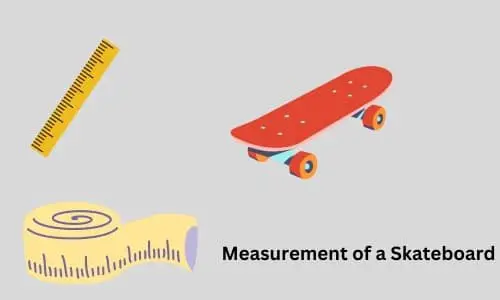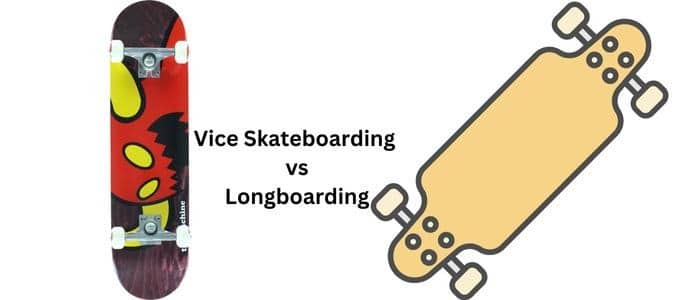How to Measure a Skateboard in a Perfect Way?
( If you purchase through our sponsored links, we may receive a small commission at no extra cost to you )
Whether you’re a seasoned skateboarder or just starting out, understanding how to measure a skateboard accurately is crucial. Proper measurements ensure that the skateboard components are well-suited to your preferences, allowing you to skate with confidence and control.
Measuring a skateboard involves assessing various aspects such as the deck, trucks, wheels, and bearings. Each component plays a vital role in determining how the skateboard performs and feels. Accurate measurements enable you to select the right-sized components, ensuring a comfortable and tailored riding experience.
Let’s get started to learn how to get the measurement of your skateboard.
Essential Tools for Measuring a Skateboard
Measuring Tape
A measuring tape is an indispensable tool for accurately measuring various aspects of a skateboard. It allows you to measure the length and width of the deck, which are crucial dimensions for determining the skateboard’s size and suitability for different riding styles.
The measuring tape typically consists of a flexible metal or cloth strip with marked measurements. To measure the length, place one end of the tape at the tip of the skateboard deck and extend it to the opposite end. For width, measure across the deck at its widest point.
Using a measuring tape ensures that you have precise measurements for a skateboard, which is essential for making informed decisions regarding deck size, trucks, and wheels.
Ruler
A ruler is another essential tool for measuring a skateboard, particularly when it comes to smaller measurements and more detailed dimensions. While a measuring tape is ideal for measuring overall length and width, a ruler provides more accuracy for smaller components like the width of the trucks or the diameter of the skateboard wheels.
A ruler typically has markings in both inches and centimeters, allowing you to choose the appropriate unit for your measurements. With a ruler, you can also measure the depth of the concave on the skateboard deck or the height of the skateboard risers, providing valuable information for customizing your skateboard setup.
Angle Finder
An angle finder is a specialized tool that comes in handy when measuring the angles on a skateboard. It allows you to accurately measure the degree of tilt or slope of various components such as the trucks and the skateboard’s kicktail.
This measurement is crucial for skateboarders who want to fine-tune their setups based on personal preferences and riding styles. The angle finder typically consists of a pivoting arm and a protractor, allowing you to align it with the component you want to measure and read the angle off the protractor scale.
By using an angle finder, you can make precise adjustments to the skateboard’s geometry, ultimately enhancing your riding experience.
Step-by-Step Instructions for Measuring the Deck
To accurately measure the dimensions of a skateboard deck, follow these step-by-step instructions
Place the skateboard deck on a flat and stable surface.
- Ensure that the skateboard is positioned horizontally, with the nose (front) and tail (back) facing away from you.
- Take a measuring tape or ruler and locate the tip of the nose. Place one end of the measuring tape or ruler at the very tip of the nose, and extend it along the top surface of the deck.
- Note the measurement where the measuring tape or ruler reaches the end of the tail. This measurement represents the length of the skateboard deck.
- To measure the width, position the measuring tape or ruler perpendicular to the length of the deck. Place one end against one side of the deck, and extend it across the widest part.
- Read and note the measurement where the measuring tape or ruler reaches the opposite side of the deck. This measurement represents the width of the skateboard deck.
- If desired, you can also measure the depth of the concave. Place the ruler or measuring tape on the deck’s surface, aligning it with the center of the deck’s width. Measure the distance from the deck’s surface to the lowest point of the concave curve.
- Ensure all measurements are recorded accurately, and use them as a reference when selecting components or customizing your skateboard setup.
By following these steps, you can measure the length, width, and concave of a skateboard deck accurately, providing valuable information for choosing the right deck size and personalizing your skateboarding experience.
Process of Measuring the Width of the Trucks
To measure the width of the trucks accurately, you can use a ruler or a measuring tape. Here’s a step-by-step process:
- Place the skateboard deck on a flat surface, with the grip tape facing up.
- Orient the skateboard in a way that allows easy access to the trucks.
- Locate the truck hangers, which are the metal T-shaped components that hold the skateboard wheels.
- Take a ruler or measuring tape and position it horizontally across the top of the truck hangers.
- Align one end of the ruler or measuring tape with the outer edge of one truck hanger.
- Extend the ruler or measuring tape until it reaches the outer edge of the opposite truck hanger.
- Read and note the measurement where the ruler or measuring tape intersects the outer edge of the truck hanger.
- This measurement represents the width of the trucks.
When measuring the truck width, it’s important to ensure that the ruler or measuring tape is placed parallel to the skateboard deck and perpendicular to the truck hangers. Taking the measurement across the widest part of the truck hangers provides an accurate representation of the truck width.
By following these steps, skateboarders can measure the width of their trucks precisely. This measurement will help them select the appropriate size of trucks that matches the width of their skateboard deck, ultimately leading to a well-balanced and optimized skateboard setup.
Measuring the Wheels
To measure the diameter of skateboard wheels accurately, follow these steps:
- Ensure the skateboard is placed on a flat surface, with the wheels facing upwards.
- Select a ruler or a measuring tape with millimeter markings.
- Locate one wheel that you want to measure.
- Position the ruler or measuring tape across the wheel’s center, from one edge to the opposite edge.
- Ensure that the ruler or measuring tape touches both edges of the wheel.
- Read and note the measurement where the ruler or measuring tape intersects the opposite edge of the wheel.
- This measurement represents the diameter of the wheel.
It’s important to measure the diameter across the widest part of the wheel to obtain an accurate measurement. Repeat the process for each wheel if you have different-sized wheels on your skateboard.
By measuring the diameter of the skateboard wheels accurately, skateboarders can select the appropriate size of wheels based on their preferred riding style and terrain. It ensures that the skateboard setup is optimized for performance, speed, and ride comfort.
Steps to Measure the Bearing Size and Compatibility
To measure the bearing size and ensure compatibility with your skateboard wheels and axles, follow these steps:
- Remove the wheels: Begin by removing the skateboard wheels from the trucks. This can usually be done by loosening the axle nuts and sliding the wheels off the axles.
- Identify the bearing size: Inspect the bearing shields, which are the metal or rubber covers on the sides of the bearings. Look for numbers imprinted on the shields, such as “608,” which represents the most common and standard bearing size for skateboards.
Other sizes may have different numbers or letters imprinted on the shields.
- Measure the bearing width: Using a ruler or caliper, measure the width of the bearing. Place the ruler or caliper across the widest part of the bearing, known as the “outer race.” This measurement will help determine the bearing width, which is typically 7mm or 8mm for skateboarding.
- Check compatibility: Ensure that the bearing size matches the axle size of your trucks. Most skateboard axles are designed to accommodate either 7mm or 8mm bearings. Match the bearing width with the corresponding axle size to ensure a proper fit.
- Repeat for all bearings: Repeat the measuring process for all the bearings to ensure consistency in size and compatibility.
When purchasing new bearings, make sure to select bearings that match the correct size (e.g., 608 for standard skateboarding) and are compatible with your skateboard axles.
By following these steps and accurately measuring the bearing size and compatibility, you can ensure that the bearings fit properly on the axles, allowing for smooth and efficient wheel rotation. This promotes better performance, speed, and overall skateboarding experience.
Riser Pad Thickness
Riser pads are placed between the skateboard deck and trucks to increase the distance between them. The thickness of the riser pad affects the skateboard’s performance in multiple ways.
To measure the thickness of a riser pad on a skateboard, follow these steps:
- Remove the skateboard trucks: Begin by removing the skateboard trucks from the deck. This can be done by unscrewing the bolts that secure the trucks to the deck using a skateboard tool or a wrench.
- Locate the riser pads: Identify the riser pads on the skateboard. Riser pads are typically placed between the skateboard deck and the baseplate of the trucks.
- Select a ruler or caliper: Choose a ruler or caliper with millimeter markings to measure the thickness of the riser pad accurately. A caliper is particularly useful for obtaining precise measurements.
- Place the ruler or caliper: Position the ruler or caliper vertically, aligning it with the edge of the riser pad. Make sure it is perpendicular to the surface of the riser pad.
- Take the measurement: Read and note the measurement where the ruler or caliper intersects the top surface of the riser pad. This measurement represents the thickness of the riser pad.
- Repeat for each riser pad: If your skateboard has multiple riser pads, repeat the process for each pad to obtain individual measurements.
By following these steps, you can accurately measure the thickness of the riser pads on your skateboard. It’s important to measure each riser pad individually as they may vary in thickness. This measurement will help you select the appropriate riser pad thickness for your specific needs and preferences.
Bolt Length Measurement
Bolt length is an important consideration when assembling the skateboard and attaching the trucks to the deck. It is crucial to select bolts that are appropriate for the skateboard’s overall thickness, including any riser pads used.
To measure the bolt length of a skateboard, follow these steps:
- Gather the necessary tools: You will need a ruler or a measuring tape with millimeter markings to measure the bolt length accurately.
- Remove a bolt from the skateboard: Choose one bolt from the set that secures the trucks to the skateboard deck. Use a skateboard tool or a wrench to unscrew and remove the bolt from the skateboard.
- Align the bolt: Place the bolt on a flat surface with the threaded end facing up. Make sure the bolt is positioned straight and not at an angle.
- Measure the bolt length: Take the ruler or measuring tape and align it along the length of the bolt from the base (the flat head or top surface) to the tip of the threaded end. Read and note the measurement where the ruler or measuring tape intersects the tip of the bolt.
- Repeat for other bolts: If your skateboard has multiple bolts, repeat the measuring process for each bolt individually to obtain their respective lengths. Note that bolts on a skateboard are typically of the same length, but it’s good practice to double-check.
By following these steps, you can accurately measure the length of the bolts used on your skateboard. It’s important to measure the bolt length to ensure proper fitting and compatibility with the skateboard deck and trucks. This will help you select the appropriate bolt length when replacing or upgrading the bolts on your skateboard.
Common Errors When Measuring Skateboards
When measuring skateboards, there are a few common errors that people may make. It’s important to be aware of these mistakes to ensure accurate measurements and a proper skateboard setup. Here are some common errors:
- Inaccurate placement: One common mistake is not properly placing the measuring tool or ruler. Placing it at an angle or not aligning it correctly with the edges of the skateboard can lead to inaccurate measurements. It’s crucial to ensure that the measuring tool is positioned parallel to the skateboard deck and perpendicular to the edges being measured.
- Misreading measurements: Another error is misreading the measurements on the ruler or measuring tape. This can happen due to not aligning the eyes correctly with the markings or misinterpreting the fractions or millimeter increments. Double-checking the readings and taking extra care in reading the measurements can help avoid this mistake.
- Neglecting the concave: When measuring the skateboard deck, some people may overlook the concave or fail to measure its depth accurately. The concave adds curvature to the deck, affecting the rider’s foot placement and control. It’s essential to measure the depth of the concave correctly to understand its impact on the skateboard’s overall feel and performance.
- Not considering truck width: Forgetting to measure or consider the truck width can lead to compatibility issues. It’s important to measure the width of the trucks accurately and ensure that it matches the width of the skateboard deck. Incompatible truck widths can result in an unbalanced setup, reduced control, and potential issues with wheelbite.
- Overlooking additional measurements: People sometimes focus only on the length and width of the skateboard deck and overlook other important measurements, such as the wheelbase or nose and tail lengths. These additional measurements can affect the board’s performance and functionality, especially for specific riding styles or preferences.
To avoid these common errors, it’s essential to take measurements with precision, double-check the readings, and consider all relevant dimensions when evaluating a skateboard setup. Taking the time to ensure accurate measurements can lead to a more enjoyable and well-suited skateboarding experience.
Conclusion
In summary, correct measurements are essential for achieving optimal performance, safety, comfort, customization, and functionality in a skateboard setup. They provide a solid foundation for a skateboard that performs at its best and suits the individual rider’s preferences and needs.





![How to Make a Doll Skateboard? [Simple & Easy Steps to Follow]](https://sportstotry.com/wp-content/uploads/2023/04/doll-skateboard.jpg)
![Why Is My Skateboard So Loud? [6 Reasons with 5 Quick Solutions]](https://sportstotry.com/wp-content/uploads/2022/04/Why-Is-My-Skateboard-So-Loud.jpg)
